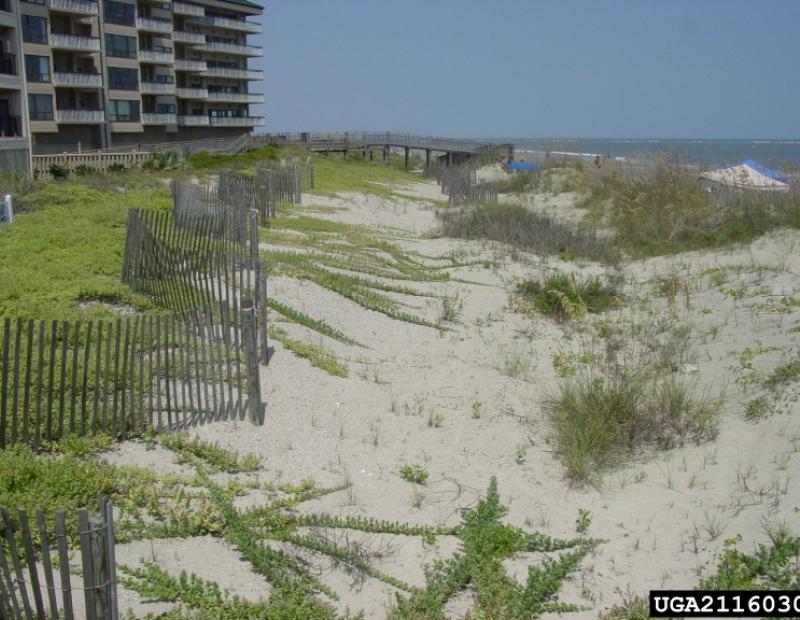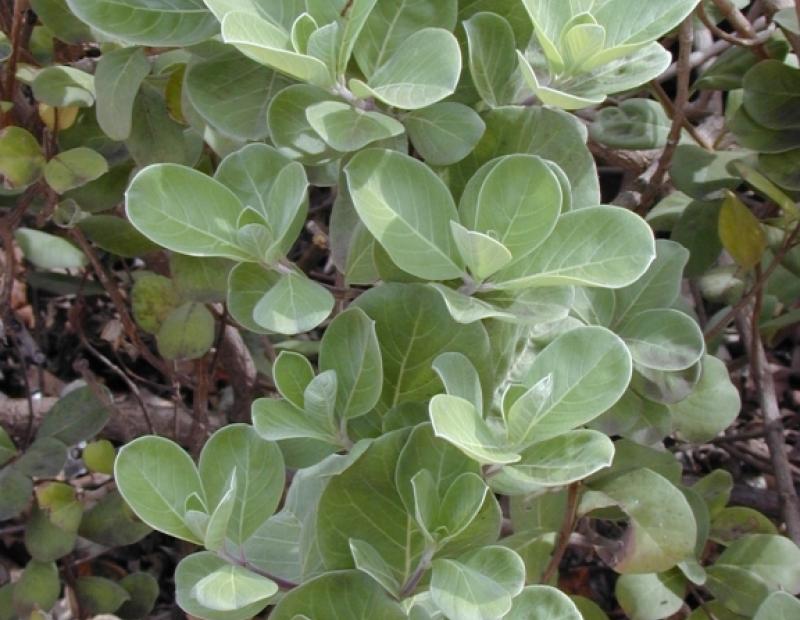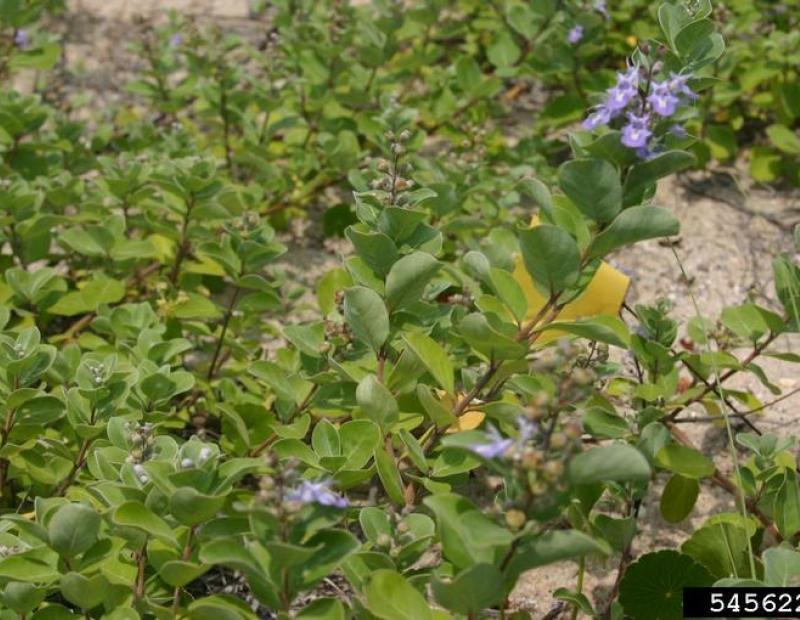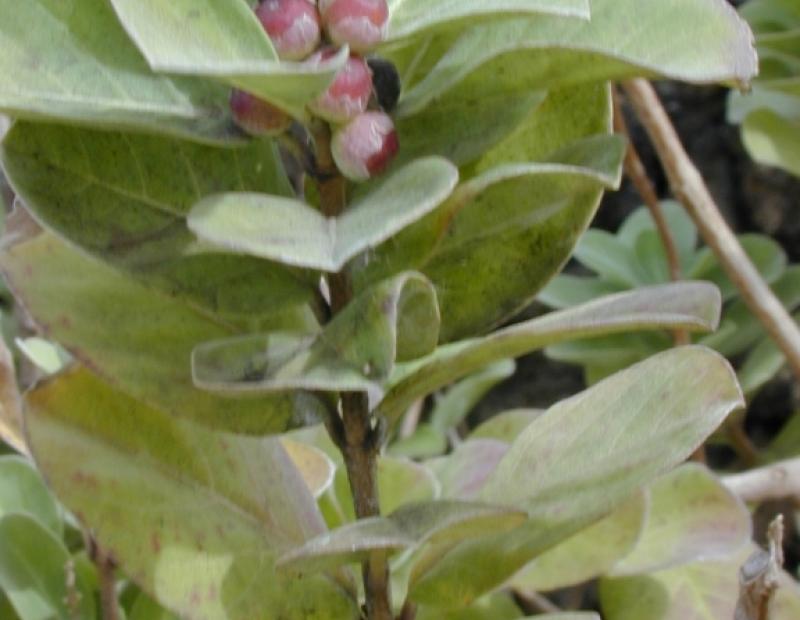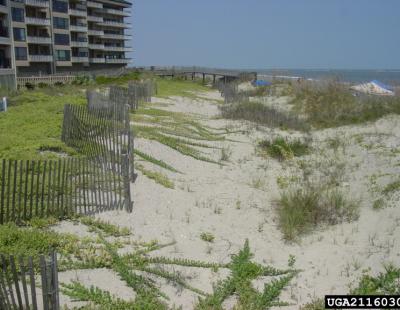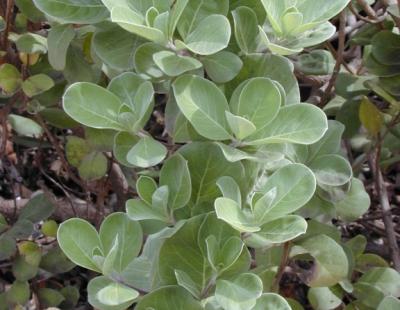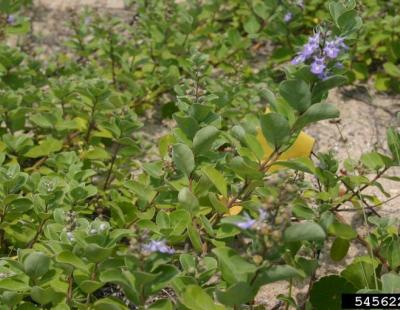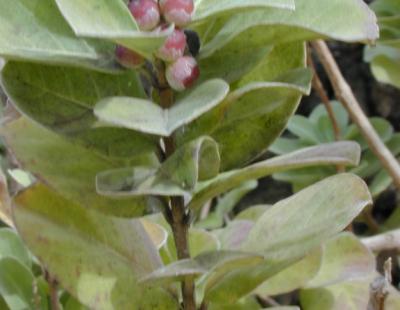Vertical Tabs
- Beach vitex is a member of the Verbana family (Verbenaceae).
- A low-growing, creeping shrub, Beach vitex can grow up to two feet high and sprawl more than 60 feet. A member of the verbena family (Verbenaceae), Beach vitex is most conspicuous throughout the summer months, when attractive blue-purple, tubular flowers appear. (3)
Leaves
Leaves are broad, oblong to oval shaped, up to two and half inches long, blue-green above and silvery below and densely hairy. When crushed, leaves have a strong, spicy aroma. (4)
Flowers
Flowers are lilac to blue to purple in color, densely hairy, zygomorphic with a prominent lower lip, and arranged in short inflorescences up to three inches long. (3,4)
Fruit/Seed
Fruit is a round, fleshy drupe approximately ¼ of an inch in diameter, turning blue-black-purple when ripe. (3, 4)
Beach vitex is an extremely aggressive shrub capable of long-distance dispersal and rapid vegetative growth. Its known ecological impacts are wide ranging and severe: nesting turtles can be impeded by this species, and the federally threatened Sea beach amaranth has been shown to be outcompeted by Beach vitex. (3) Soils under Beach vitex are extremely hydrophobic and densely shaded, making them inhospitable to other types of vegetation. Furthermore, this species does not retain sand as efficiently as other types of native beach vegetation, making the habitats Beach vitex colonizes more susceptible to erosion. (9)
Biological Control
There is no biological control agent available at this time.
Manual or Mechanical Control
Pulling / Digging Up: Not advisable. Underground runners are abundant and will rapidly regenerate. (3)
Mowing: Mowing and other forms of cutting will control fruiting of Beach vitex but will not eradicate populations unless paired with a method of herbicide application. (6)
Girdling: Not applicable
Prescribed Fire: No information available
Prescribed Grazing: No information available
Soil Tilling: No information available
Mulching: No information available
Solarization: No information available
Hot Foam Spray: No information available
Chemical Control
The pesticide application rates and usage herein are recommendations based on research and interviews with land managers. When considering the use of pesticides, it is your responsibility to fully understand the laws, regulations and best practices required to apply pesticides in a responsible manner. At times, the pest you seek to treat may not be on a pesticide label, requiring a 2ee exemption from NYSDEC. Always thoroughly read the label of any pesticide and consult the NYSDEC or a licensed pesticide applicator with questions.
Foliar Spray: A 6-9% foliar spray of imazypyr is effective against Beach vitex. Repeat applications may be necessary. Always read and follow all directions on the label (6)
Cut Stump: Not applicable
Basal Bark: Not applicable
Stem Injection: Not applicable
Pre-Emergent Spray: No information available
General management overview and recommendation
As with any other invasive infestation complex, Beach vitex is best managed via a combination of mechanical and chemical means. Very small populations may be effectively controlled by careful hand pulling. Larger populations warrant foliar spray application after cutting. All managed infestations should be monitored for at least four years to manage any germination of new seedlings that occurs. New seedlings can be hand pulled or sprayed.
Post treatment monitoring
Controlled populations should be revisited for at least four years to ensure no germination of new seedlings has occurred. (9)
Disposal Methods
All cut stems of Beach vitex must be bagged of and disposed of in a landfill. (6, 8)
REFERENCES
- https://www.dec.ny.gov/docs/lands_forests_pdf/isprohibitedplants2.pdf
- https://www.eddmaps.org/species/subject.cfm?sub=11609
- https://www.cabi.org/isc/datasheet/56553
- http://www.missouribotanicalgarden.org/PlantFinder/PlantFinderDetails.as...
- http://bugwoodcloud.org/resource/pdf/FHTET-2017-05_New%20Invaders_SE.pdf
- https://hgic.clemson.edu/factsheet/identifying-managing-beach-vitex/
- http://hrijournal.org/doi/full/10.24266/0738-2898-34.1.1
- https://www.fws.gov/nc-es/port/BeachVitexposter.pdf
- https://www.aphis.usda.gov/plant_health/plant_pest_info/weeds/downloads/...

